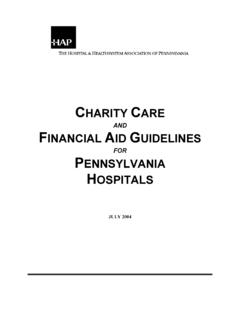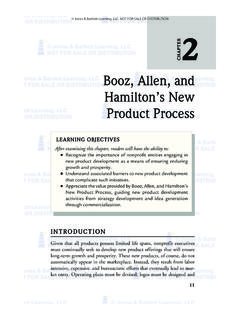Transcription of Executive Summary Value Nonprofit organizations …
1 Executive SummaryNonprofit organizations have historically played, and continue to play, a critical role in the financing and delivery of health care services in the United States. About 60 percent of community hospitals are Nonprofit , all community health centers are Nonprofit , almost 30 percent of nursing homes are Nonprofit , and about 17 percent of home health care agencies are estimated to be Nonprofit . Nonprofit health plans are estimated to serve over 40 percent or more of all private health insurance enrollees. The Nonprofit sector is where we go for solving our most troubling social problems. It is where we go to protect our values and culture. The Nonprofit sector is society s safety net. Nonprofit health care organizations are primarily responsible and accountable to the communities and populations they serve. They are legally and ethically bound to do good for the benefit of their communities.
2 Their governing bodies are comprised of leaders from the communities they serve. Rather than inuring to the benefit of private owners, the earnings and reserves of Nonprofit health care organizations are reinvested to benefit the lu eHealth Care of Nonprofit2 The preponderance of studies document that Nonprofit health care organizations provide significantly more community benefits than their for-profit health counterparts. While not always counted as a community benefit, research has also shown that Nonprofit health care organizations are less likely to abandon services or products or to withdraw from markets that have declining aside community benefits, conceptually one would expect Nonprofit and for-profit health care organizations to be performing in other ways that are indistinguishable from one another financing and/or delivering care in compassionate, safe, quality, ethical and efficient manners.
3 Even on many of these dimensions, however, studies indicate that Nonprofit health care organizations as a whole have been generally outperforming for-profit government officials and others have proposed the establishment of quantitative standards for community benefits, Executive or board compensation, earnings, and/or reserves. Yet Nonprofit health care organizations with community-oriented boards were created in the first place to make these difficult judgment calls balancing in a dynamic fashion the community s needs and competitive and other challenges facing the organization with its financial public opinion polling indicates that 80 to 90 percent of Americans appear to think that ownership in health care does matters. Unfortunately, almost two-thirds of those polled don t know if the health care providers or insurers they rely upon in their own communities are Nonprofit or for-profit, nor are they aware of Nonprofit health care s positive performance reflected in these one can expect policymakers and opinion leaders to be better informed, the growing public scrutiny of Nonprofit health care suggests that much more needs to be done to both educate them and to address their questions and concerns.
4 IntroductionNonprofit organizations have historically played, and continue to play, a critical role in the financing and delivery of health care services in the United States. Nonprofit health care organizations are part of the economy s third sector, which is distinct, yet highly interdependent with, the other two sectors government and the for-profit business sector. The country s first hospital, the Pennsylvania Hospital, was founded in 1751 as a Nonprofit facility and continues to operate as such today. About a century-and-a-half later, the first health care prepayment/insurance plan Blue Cross was founded as a Nonprofit organization by a Nonprofit hospital in Texas. Today about 60 percent of community hospitals are Nonprofit , all community health centers are Nonprofit , almost 30 percent of nursing homes are Nonprofit , and about 17 percent of home health care agencies are estimated to be Nonprofit .
5 Nonprofit health plans1 are estimated to serve over 40 percent or more of all private health insurance enrollees. Differences between the Nonprofit and Other SectorsIn our capitalistic economy, it is unavoidable that there would be several forms of ownership in sectors like health care and education, which provide public good : There are simply things that for-profit enterprises just won t do because the profit potential is inadequate. Similarly, there are things that as a society we do not want government to do. Yet there are some things that still must be done. It is for these needs that we have created Nonprofit enterprises in health care and Nonprofit sector is where we go for solving our most troubling social problems. It is where we go to protect our values and culture. The Nonprofit sector is society s safety net. As with other parts of the Nonprofit and for-profit sectors, there is a fundamental difference in the overall purposes of Nonprofit and for-profit health care organizations .
6 For-profit health care organizations are legally and ethically responsible primarily to their owners and/or stockholders, and are obligated to do well for the benefit of these owners. Their primary goal is private inurement. As a consequence, for-profit health care performance can be measured most simply by profitability and return on equity for health care organizations , on the other hand, are primarily responsible and accountable to the communities and populations they serve. They are legally and ethically bound to do good for the benefit of their communities. Their governing bodies are comprised of leaders from the communities they serve. Rather than inuring to the benefit of private owners, the earnings and reserves of Nonprofit health care organizations are reinvested to benefit the community. A portion of those investments are made to improve quality, service, and efficiency, usually in highly competitive The remaining investments are made in a variety of community programs, services, or products that do not cover their costs, in order to improve the health status of vulnerable populations and the broader community.
7 Examples of such investments, commonly referred to as community benefits, 3 include: Providing safety-net insurance products to individuals unable to purchase group coverage or to obtain pubic program coverage. Charging no fee or a discounted fee to uninsured, low-income, or medically indigent patients for needed health care services. Providing unprofitable health care services such as trauma care, burn care, and outreach primary care and preventive services. Supporting and participating in communitywide health planning efforts to identify and rank needs. Providing or supporting medical education or research. Conducting community health education programs. Supporting community development projects to improve housing, jobs, the physical environment, child or adolescent education, etc. Making donations to other Nonprofit organizations in the Results of Studies of Nonprofit Health Care PerformanceThe preponderance of studies document that Nonprofit health care organizations provide significantly more community benefits than their for-profit health ,6 While not always counted as a community benefit, research has also shown that Nonprofit health care organizations are less likely to abandon services or products or to withdraw from markets that have declining profitability.
8 For instance, for-profit hospitals carefully select what states and communities they enter and exit, and what specific types of services they offer or discontinue, in order to maximize returns on their investments. Similarly, for-profit health insurers have been much more likely to stop participating in Medicare and Medicaid managed care programs in response to declining Setting aside community benefits, conceptually one would expect Nonprofit and for-profit health care organizations to be performing in other ways that are indistinguishable from one another financing and/or delivering care in compassionate, safe, quality, ethical, and efficient manners. Even on many of these dimensions, however, studies indicate that Nonprofit health care organizations as a whole have been generally outperforming for-profit For instance: Nonprofit health care providers and insurers provide their services in a more trustworthy manner.
9 They are less likely to make misleading claims, less likely to have complaints lodged against them by patients or members, and less likely to treat less-empowered people in a manner different than other clientele. Nonprofit health care providers and insurers typically provide their services at lower prices. Nonprofit health care providers and insurers are predominately the pioneers in the development of new services, using philanthropy and cross subsidies to finance service innovations. The top-rated health plans for quality and member satisfaction have been predominately Nonprofit . In addition, Nonprofit health plans typically have higher medical loss ratios, meaning that more of the premium dollar is spent on actual health care services rather than on administrative costs and Nonprofit hospitals have lower costs and higher quality, in terms of somewhat lower mortality rates.
10 Nonprofit nursing homes, while having higher costs, provide markedly higher quality, in terms of lower rates of adverse events, and are underrepresented in many communities from a consumer welfare Nonprofit renal dialysis facilities provide higher quality, in terms of somewhat lower mortality rates. Only one (5 percent) of the top twenty largest health care fraud settlements over a twenty-year period, under the False Claims Act, involved a Nonprofit health care The foregoing demonstrates that there is great community and societal Value in Nonprofit health care enterprises. They provide the most personal and essential of services often beyond the reach of the competitive marketplace and outside the grasp of what the public wishes in the way of government ForwardDespite all of the previous evidence, some government officials and others have proposed the establishment of quantitative standards for community benefits, Executive or board compensation, earnings, and/or reserves.










